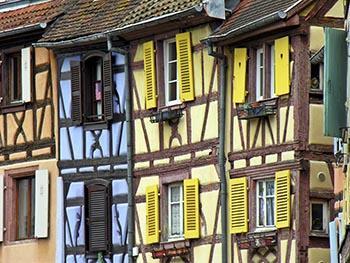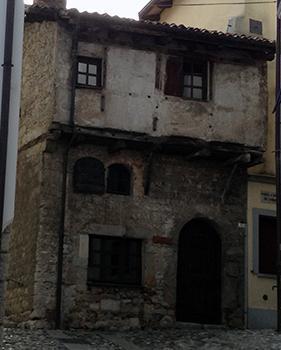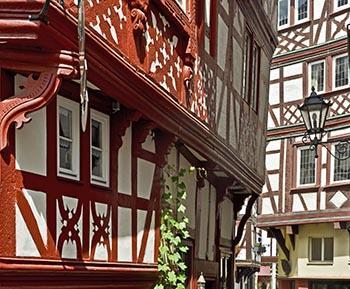Opus craticium
Post from EditorialsThe opus craticium is an ancient building technique (invented by the ancient Romans) but still widespread in traditional houses especially in Northern Europe.
Opus craticium or Trellis work
 Opus craticium, or Trellis work, is a very simple construction technique for the construction of buildings with load-bearing structure completely in wood.
Opus craticium, or Trellis work, is a very simple construction technique for the construction of buildings with load-bearing structure completely in wood.
In addition to the floors and the coverage, this material is in fact also used in the structures of vertical elevation (ie, the load-bearing walls and partitions) thanks to the creation of a frame (or trellis, hence the name) formed from vertical uprights and horizontal crosspieces diagonal bracing elements connected by joints of various kinds.
The real carriers are obviously the uprights, which according to the rules of art stand on a plinth basement stone or brick (sometimes corresponding to the entire ground floor) with the essential function to protect the wood from the soil moisture, ensuring a long life. In correspondence of the floor of each floor is instead placed a long horizontal beam necessary to share the vertical loads and allow the use of shorter vertical elements: the height of the uprights coincides with that of a floor, because it was not easy to find and carry trees with tall trunks and straight, and also the construction of one building required a lot of timber. The horizontal elements and diagonal instead serve to stiffen the structure (making it non-deformable) and to distribute the loads in an optimal way.
The horizontal elements and diagonal instead serve to stiffen the structure (making it non-deformable) and to distribute the loads in an optimal way.
Doors and windows are obtained during the construction of the frame by simply leaving open the corresponding openings.
Completed the work of carpentry, the trellis - almost always left in sight generating the compositional effects typical of this system - was padded with various types of material: stone walls, terracotta bricks, wooden planks, clay mixed with straw or even (in poorest constructions and internal partitions) plastered canework.
Opus craticium in Italy
 L 'opus craticium is a very old building system adopted and circulated by the Romans to build quickly (and cheaply) very high buildings such as insulae, tenements and apartments similar to current condominiums.
L 'opus craticium is a very old building system adopted and circulated by the Romans to build quickly (and cheaply) very high buildings such as insulae, tenements and apartments similar to current condominiums.
Later, in the early Middle Age this technique was widely used throughout Europe for the construction of entire buildings or individual parts of them as the partitions and the overhanging roofs: in The effects of bad governance in the city, painted by Ambrogio Lorenzetti in the mid-fourteenth century on the first floor of the Palazzo Pubblico of Siena, we see such a projection now decrepit built exactly with the trellis system.
In the historic city centers in Northern Europe (especially in France, Germany, England, Switzerland, Belgium and Poland) and - at a much lesser extent - also in Italy there are still beautiful half-timbered houses (also of great aesthetic and architectural appeal), called fachwerkhaüser in the German-speaking countries: in our country there are some especially in the Northern cities and towns in the Alps, including for example Como, Arquata Scrivia in the province of Alessandria and Cividale del Fiuli.
You may also notice this building technique even in rural buildings older than the poorest and most isolated areas, such as the high hills or the Apennines: according to some witnesses, on the Bolognese hills there are still some houses - often abandoned for some time and so now crumbling - in which all the internal partitions are made of wooden pylons infilled with plastered canework.
Recognizing this technique and understand how it works is therefore very important not only to intervene successfully on ancient buildings still inhabited (it is obvious - for example - that in buildings with trellis structure one must be very careful in the creation of electrical discharges under the plaster and wall ) but especially in the recovery of abandoned rural buildings, in need of real restorations for their high historical value and testimonial.
Fachwerk, a German tradition
 But it is in Germany that the opus craticium - locally called fachwerk - produced its masterpieces: this construction technique, extremely popular until the nineteenth century (to the point of creating whole streets and neighborhoods of half-timbered houses), in centuries of evolution in fact codified many decorative styles and compositional solutions characteristics of each place or period, of great aesthetic value.
But it is in Germany that the opus craticium - locally called fachwerk - produced its masterpieces: this construction technique, extremely popular until the nineteenth century (to the point of creating whole streets and neighborhoods of half-timbered houses), in centuries of evolution in fact codified many decorative styles and compositional solutions characteristics of each place or period, of great aesthetic value.
The elements of the wooden frame are in fact modified and multiplied to create real decorative braids obtained by the combination of precise formal elements, including for example:
- The cross of St. Andrew in the form of X, used for the composition of mirrors and ornamental frames similar to the string courses;
- The wild man, constituted by a set of diagonal beams arranged to form a sort of cross;
- Turbot and lozenges, visible especially under the benches of the windows;
- Bracing oblique modular sequences.
The geometric perfection and the modularity of the wooden frame are placed carefully in prominence thanks to the light color of the paddings, generally plastered with one color.
In the richest fachwerkhaüser there are also purely ornamental elements, such as richly carved corbels to support the typical jetties of the upper floors, statues of saints, plates with inscriptions and ornamental frames, and even elements of the supporting structure flaunt rich decorations carved or painted.
80321 REGISTERED USERS










